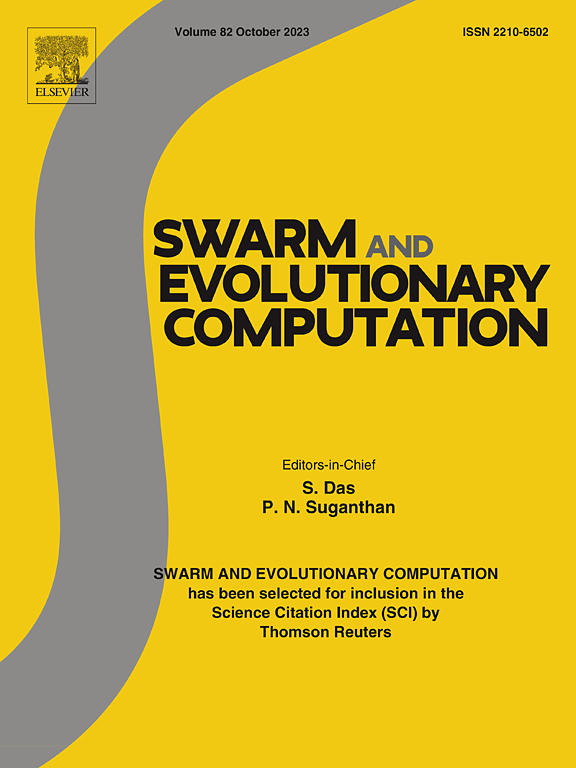Metaheuristic-optimized TabNet ensemble for accurate and interpretable obesity classification
IF 8.5
1区 计算机科学
Q1 COMPUTER SCIENCE, ARTIFICIAL INTELLIGENCE
引用次数: 0
Abstract
Obesity is a complex global health issue with severe implications for both individual well-being and public health systems. It has been traditionally challenging to predict and diagnose due to its multifactorial nature, involving genetic, behavioral, and environmental factors. While classical regression models have been extensively used for obesity prediction, their limitations have prompted the exploration of more advanced methodologies. In this study, we leverage Deep Learning (DL) techniques, particularly TabNet, to address the challenges of obesity classification in tabular data—a domain where DL’s potential has often been underutilized. Our approach enhances the TabNet architecture through effective hyperparameter tuning, utilizing Particle Swarm Optimization (PSO), Grey Wolf Optimizer (GWO), and Hunger Games Search (HGS). The resulting models, TabNet-PSO, TabNet-GWO, and TabNet-HGS are combined into a novel ensemble that demonstrates superior performance in obesity classification compared to conventional machine-learning models and recent studies. Additionally, Explainable Artificial Intelligence techniques are employed to provide both local and global interpretability of model predictions, using SHapley Additive exPlanations (SHAP). This interpretability is crucial in clinical settings, where understanding the underlying factors influencing predictions is essential. The study’s findings offer significant contributions to the early detection and management of obesity, providing healthcare professionals with precise and interpretable predictions to guide intervention strategies.
meta启发式优化的TabNet集成,用于准确和可解释的肥胖分类
肥胖是一个复杂的全球健康问题,对个人福祉和公共卫生系统都有严重影响。由于其多因素的性质,包括遗传、行为和环境因素,传统上一直具有预测和诊断的挑战性。虽然经典回归模型已广泛用于肥胖预测,但其局限性促使人们探索更先进的方法。在这项研究中,我们利用深度学习(DL)技术,特别是TabNet,来解决表格数据中肥胖分类的挑战——在这个领域,深度学习的潜力往往没有得到充分利用。我们的方法通过有效的超参数调整,利用粒子群优化(PSO)、灰狼优化器(GWO)和饥饿游戏搜索(HGS)来增强TabNet架构。由此产生的模型TabNet-PSO、TabNet-GWO和TabNet-HGS被组合成一个新的集合,与传统的机器学习模型和最近的研究相比,在肥胖分类方面表现出了优越的性能。此外,可解释的人工智能技术使用SHapley加性解释(SHAP)来提供模型预测的局部和全局可解释性。这种可解释性在临床环境中至关重要,在临床环境中,理解影响预测的潜在因素是必不可少的。这项研究的发现为肥胖的早期发现和管理提供了重要的贡献,为医疗保健专业人员提供了精确和可解释的预测,以指导干预策略。
本文章由计算机程序翻译,如有差异,请以英文原文为准。
求助全文
约1分钟内获得全文
求助全文
来源期刊

Swarm and Evolutionary Computation
COMPUTER SCIENCE, ARTIFICIAL INTELLIGENCEC-COMPUTER SCIENCE, THEORY & METHODS
CiteScore
16.00
自引率
12.00%
发文量
169
期刊介绍:
Swarm and Evolutionary Computation is a pioneering peer-reviewed journal focused on the latest research and advancements in nature-inspired intelligent computation using swarm and evolutionary algorithms. It covers theoretical, experimental, and practical aspects of these paradigms and their hybrids, promoting interdisciplinary research. The journal prioritizes the publication of high-quality, original articles that push the boundaries of evolutionary computation and swarm intelligence. Additionally, it welcomes survey papers on current topics and novel applications. Topics of interest include but are not limited to: Genetic Algorithms, and Genetic Programming, Evolution Strategies, and Evolutionary Programming, Differential Evolution, Artificial Immune Systems, Particle Swarms, Ant Colony, Bacterial Foraging, Artificial Bees, Fireflies Algorithm, Harmony Search, Artificial Life, Digital Organisms, Estimation of Distribution Algorithms, Stochastic Diffusion Search, Quantum Computing, Nano Computing, Membrane Computing, Human-centric Computing, Hybridization of Algorithms, Memetic Computing, Autonomic Computing, Self-organizing systems, Combinatorial, Discrete, Binary, Constrained, Multi-objective, Multi-modal, Dynamic, and Large-scale Optimization.
 求助内容:
求助内容: 应助结果提醒方式:
应助结果提醒方式:


